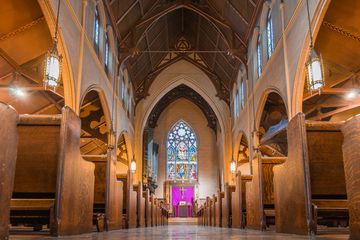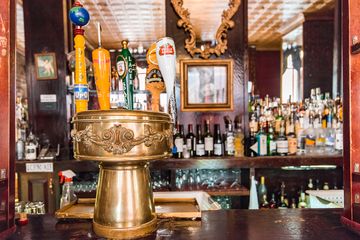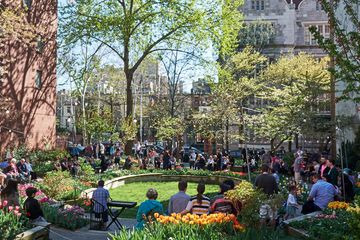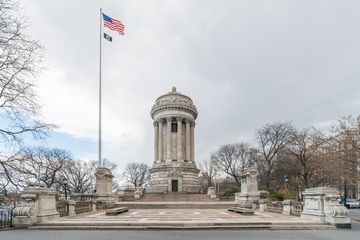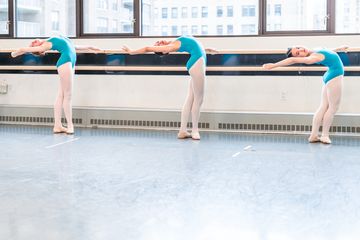What began as a grassroots dance school that emphasized performances for the community has since grown into a world-class institution, acclaimed for its facilities and programs. Ballet Hispanico was founded in 1970 by Tina Ramirez, a Venezuelan dancer with Puerto Rican and Mexican parentage. Her career included performing in the Federico Rey Dance Company as well as in Broadway productions of Kismet and Lute Song. Eduardo Vilaro took over from Tina Ramirez as Artistic Director in 2009. Eduardo, who grew up in the Bronx, has been part of the Ballet Hispanico family since 1985 and spent many years helping to expand the company and to create new programming. In chatting with Eduardo, I was able to learn more of the company's origin, beginning with the purpose for its inception: to provide a place where Latinos could “follow a dream in the performing arts. ” Before the company, there were no places in the city that truly embraced Latino dancers and enabled them to practice their talents and excel in the arts. Initially, students from the school danced everywhere, including at street fairs and in parks, to expose the community to Latino dances and choreography and to show that there was “more than just West Side Story. ” They took the folkloric roots of dance and ran with them, creating modern, carefully honed dance forms. In Eduardo’s words, “We are not a folkloric company. We take culture and investigate it through the lens of artists in contemporary culture. ” Where folkloric dance can tend to feel like a museum piece, Ballet Hispanico is “relevant forever. ”Though students at Ballet Hispanico are trained in ballet, what sets the school apart is that by enrolling in the various programs, dancers are expected to become proficient in three main forms: flamenco, Cuban classical, and contemporary. Eduardo explained that Ballet Hispanico is “one of the few places in New York City where a child can train in flamenco. ” Though Ballet Hispanico offers classes to both children and adults, Eduardo especially appreciates his interactions with young people. “These programs keep me fresh - working with youth is so refreshing. ”I was able to witness a class full of those young students. On one of their upper floors, children age ten to twelve were arrayed around the room, holding onto the ballet barres as they rehearsed for their spring production. The teacher walked through the space, meticulously correcting their stances and declaring ballet terminology that the very serious dancers recognized and followed. The class was incredibly diverse, including three young boys. At the end, most of the children excitedly headed upstairs for a second class, this one focusing on flamenco. As I chatted with a few of these precious children, I found the difference between the concentrated, disciplined faces in the class and the excited, eager expressions in the hallway both heart-warming and impressive. A few told me that they had been dancing since they were two years old. An unexpected, yet exciting moment was when I was invited to step inside Ballet Hispanico’s costume room where Diana, known to everyone as “D, ” has worked for eight years, creating the outfits that the students and company members wear for performances. The room was filled with a variety of costumes in all shapes and sizes. As I stood in awe, D pointed to a flamenco outfit hanging on a high shelf, sharing with me that it was one of Tina Ramirez’s original costumes. When I looked at her and said what an amazing job she has, she simply responded, “I love designing for the company. ”In addition to the school and the company, Ballet Hispanico is involved in "social justice, " of which Eduardo is very proud. They work with youths in shelters, providing the children both with a creative outlet and food. Eduardo also mentioned that the company has worked with incarcerated youth, saying “It changes us more than it changes them. ” Additionally, after the travel ban was lifted in 2014, Ballet Hispanico was the first Latino company to travel to Cuba. On a more personal level, Ballet Hispanico helps Latinos to find their place in the world. “When you are a ‘ripped from my land’ immigrant, it changes you, ” Eduardo said, asking, “Who are we as Latinos in America? ” The arts, Eduardo insisted, are the best way to create a dialogue about “who we are. ” If dance is, as Eduardo suggests, a language all to itself, Ballet Hispanico is proficient in many different dialects. Like the Latino cultures that it aims to represent in the dance world, Ballet Hispanico’s programs are incredibly varied and far-reaching. As Eduardo so nicely phrased it, “Ballet Hispanico is a metaphor for culture. ”
